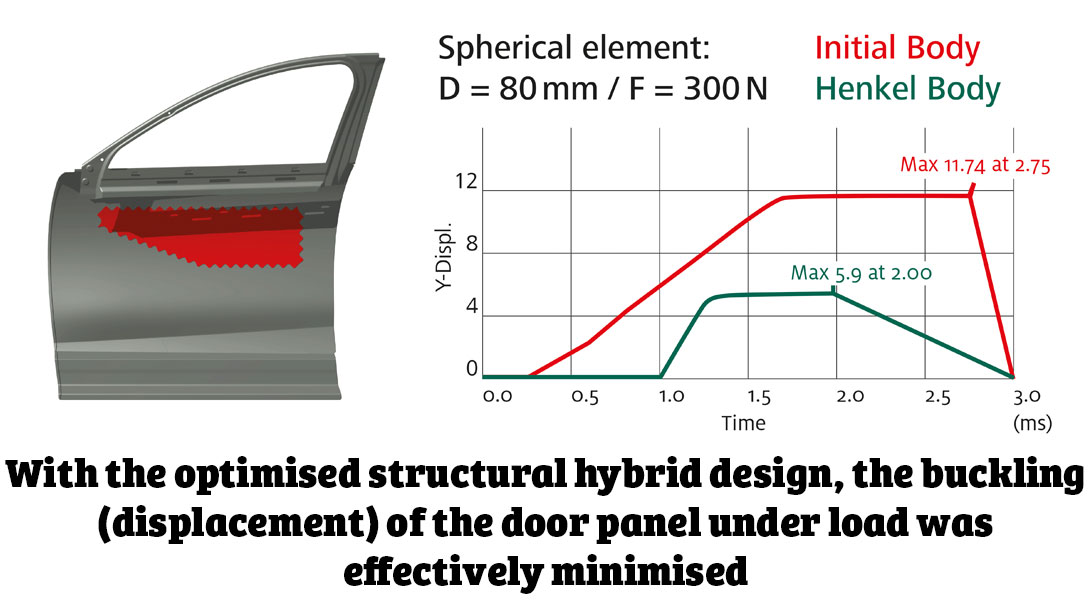
In a comprehensive joint study, Henkel and RLE International have examined and validated the potential of high performance structural foam for lightweighting in automotive body and closure parts.
The study revealed that fibre reinforced polymer components with structural foam ribbing and reinforcements can save more than 40kg of weight per car versus conventional all metal designs.
Body components and especially closures have always been in the focus of lightweighting in automotive engineering, since they form some of the biggest parts of vehicles. Even one tenth of a millimetre in thickness can mean several kilos in overall weight, with subsequent effects on fuel or electrical power consumption, as well as carbon emissions. In most modern cars, however, the engineering limit on thickness and steel grades are definitely a challenge, so further thickness reductions can create problems in meeting the required mechanical strength and crash protection.
“In a radical new approach, we investigated the possibilities of overcoming these constraints by replacing traditional all metal designs with hybrid fibre and structural foam reinforced polymer solutions,” says David Caro, head of global engineering, OEM design, automotive and transportation at Henkel. “The results of our study have confirmed that we can achieve significant further weight reductions without compromising the safety in typical crash scenarios by optimising the stiffness of fibre reinforced plastic frames or carriers with selective foam ribbing and reinforcements, with competitive costs.”
The hybrid parts feature a solid frame or carrier moulded in higher percent fibre reinforced polymers (FRP) and selective reinforcements using Henkel’s Teroson EP structural foam, a commercially available epoxy-based material that delivers high strength and stiffness at extremely low weight. The foam is injected into the carrier at predefined sections, expands in the e-coat oven and creates a stiff connection between the hybrid component and adjacent parts in the body-in-white.
Non-cured, it is resistant to normal automotive washing and phosphating solutions, as well as to electro-dip coating. Curing then takes place within 15 minutes or less, depending on the specific foam grade.

The comprehensive project included all major body and closure parts of an SUV vehicle, from the bumpers, fenders, pillars and doors to the rocker panel, side panels and tailgate. “The final designs were arrived at in several consecutive optimisation cycles, based on extensive finite-element engineering and crash simulations in-line with standard specifications,” explains Tobias Wigand, project manager, new business development, RLE International. “In some cases, such as the side doors, our hybrid structural plastic and foam solution was even capable of exceeding the expected performance when compared with the initial all aluminium design.”
The crash simulations performed in the study strictly adhered to demanding international automotive standards, such as offset and small overlap frontal crash testing according to the European New Car Assessment Programme (Euro NCAP) and the Insurance Institute of Highway Safety (IIHS) at speeds of 64km/h and 50km/h, respectively. The side (or pole) crash performance was tested according to US NCAP specifications at 32km/h. The rear impact scenario was simulated with a 60km/h moving barrier onto a fixed test vehicle as defined by US Federal Motor Vehicle Safety Standard (FMVSS) No. 301. Another IIHS test standard was applied to establish the roof crush behaviour.
Altogether, the hybrid designs with Henkel’s Teroson EP structural foam were found to pass all these tests well within the limits of deformation and intrusion, while offering substantial weight savings versus conventional all metal components. Henkel and RLE International are offering their hybrid structural design technology as an encompassing joint approach from concept to launch and series production, ensuring the process security and sustainability of all development, engineering and material processes. Each design is fully engineered and optimised for all pertinent crash load cases according to customer specifications and applicable industry standards.

Will joined Fastener + Fixing Magazine in 2007 and over the last 15 years has experienced every facet of the fastener sector - interviewing key figures within the industry and visiting leading companies and exhibitions around the globe.
Will manages the content strategy across all platforms and is the guardian for the high editorial standards that the Magazine is renowned.
Don't have an account? Sign Up
Signing up to Fastener + Fixing Magazine enables you to manage your account details.